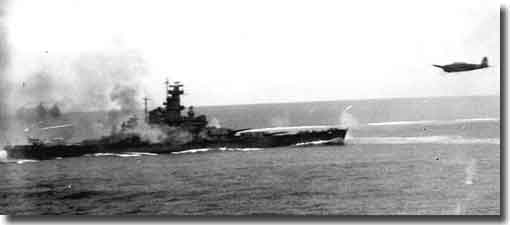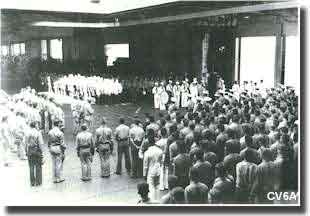|
USS Enterprise, Battle of Santa Cruz 26 October 1942
 | Introduction.
Although the Japanese had lost at Cape Esperence, it was not a body blow, and only caused them to try even harder to dislodge the Marines from Guadalcanal and retake Henderson field.
Esperence set the scene for another major encounter of the carrier forces of the US and Japan, to be the last of its kind in the Solomons arena.
One big Japanese push.
With the death of Rear Admiral Goto, he was replaced by Vice Admiral Takeo Kurita, he had two battleships Kongo and Haruna, with 8 by 14 inch guns in four turrets, plus 16 by 6 inch guns in barbettes.
On the 13th. of October, just west of Savo, they plastered Henderson Field with high explosive shells and just about obliterated the airfield.
This was followed up the next night when Vice Admiral Mikawa with his heavy cruisers Ckokai and Kurusaga fired off 752 by 8 inch shells. On the 15th. of October, 6 transports rushed troops ashore, and that night the cruisers Maya and Myoko added their bombardment contribution.
Meantime, Nimitz was backing Halsey's appointment to the South Pacific Command by organising a task force with the new battleship Indiana in from the Atlantic, the 25th. Infantry Division from Oahu, and 50 more army planes to join the South Pacific front, plus a number of submarines to be available to his new commander.
The combined fleet from Truk was to stand off north of the Solomons, land carrier planes on Henderson Field, and clean up any stray US fleet around, the target date being the 25th. of October.
But, and it was a very big but! Lieutenant General Maruyama on Guadalcanal had to wrest the airfield from the tight grasp of the Marines.
Two attempts to deliver this outcome almost succeeded, but in the end they were driven off by the 25th. of October, and the Combined Fleet retired back to Truk.
The two groups of Naval Forces.
Yamamoto had available in several groups poised NE of the Solomons, 4 carriers, 5 battleships, 14 cruisers and 44 destroyers, somewhere in the south, the US had 1 or 2 carriers, 3 to 5 battleships, 5 to 8 cruisers and a number of destroyers.
But the real question for the Japanese Naval Commander was: "How many carriers did the Americans really have? and even more importantly, where were they?"
Yamamoto decided, he ordered Vice Admiral Kondo to press forward and engage the enemy naval ships.
The Japanese strike force included Vice Admiral Nagumo's carriers, Shokaku, Zuikaku, and Zuibo, one heavy cruiser and 8 destroyers. Rear Admiral Abe's group made up of the battleships Hiei and Kirishi, 2 heavy cruisers, 1 light cruiser and 7 destroyers.
Rear Admiral Kakata's Second Fleet Air Group had the light carrier Junyo, and 2 destroyers.
Finally, Kondo himself had available 4 heavy cruisers, 1 light cruiser and 6 destroyers.
There were 200 planes aboard the carriers, plus 12 submarines in the area, and at Rabaul, Mikawa's cruisers and destroyers.
All in all, a mighty armada.
In turn, Halsey had 2 battle groups:-
Rear Admiral Thomas Kinkaid's TF 16, the carrier Enterprise, the battleship South Dakota, 2 heavy cruisers and 8 destroyers.
Rear Admiral George Murray's TF 17, with the carrier Hornet, 2 heavy cruisers, 2 light cruisers and 6 destroyers.
Rear Admiral Wallis Lee's battleship Washington, 2 heavy cruisers, 2 light cruisers and 6 destroyers.
Halsey had told Kinkaid to make an aggressive sweep north of Santa Cruz Island
Japanese carrier force sighted.
Just after noon on the 25th. of October, a Catalina out of Espiritru Santo reported sighting a carrier group 360 miles north west of Kinkaid and his TF.
At 1430 ( 2.30 PM ) Kinkaid launched 12 Dauntless bombers to search in 200 mile legs from west to north.
An hour later, a strike of 12 Dauntless, 6 Avengers with an escort of 11 Wildcat fighters was sent on its way.
But Nagumo had turned his group northwards again, and so evaded this US strike force.
Just after midnight on the 26th. the Catalinas again found Nagumo's carriers.
Halsey's order to the fleet was short and simple: "Strike! repeat Strike!"
At 0605 ( 6.05 AM ) 16 Dauntless flew off the flight deck from Enterprise.
200 miles NW of Kinkaid the Japanese carriers Skokaku, Zuikaka were found, Zuibo although not yet sighted at this time, was part of this force.
But her luck did not last, she was soon sighted by some of this Enterprise attack force, and 2 by 500 pound bombs blasted a 50 foot hole aft in her flight deck, this damage put her out of action for months.
A Japanese scout plane had found Hornet, and the Japanese had 65 aircraft in the skies, all seeking the US carrier.
By 0900 ( 9 AM ) Enterprise had all her aircraft aloft, and Hornet launched a further 25 planes.
The 2 US carriers with 169 aircraft faced 4 Japanese carriers with a total of 212 aircraft available.
The two opposing air strikes pass each other.
A bizarre incident, 60 miles out from Enterprise, the two groups of aircraft from the US and Japanese carriers actually passed each other, each intent on making for their respective enemy ships, and they ignored each other and pressed on.
Between the two fighter groups various dog fights took place with casualties inflicted to both sides.
Hornet was hit by bombs, and then took two torpedoes, blowing two 15 by 30 foot holes in the hull starboard side, now with Hornet disabled, the Enterprise became the last US carrier standing in the South Pacific.
Dauntless from Hornet attacked the heavy cruiser Chikuma scoring 2 or more direct bomb hits, but she managed to survive.
Shokaku was hit by at least three 1,000 pound bombs, her flight deck destroyed, and putting her out of action for 9 months.
Enterprise backed up by South Dakota were both subjected to intense attacks, two bombs struck Enterprise, but she continued to steam, and a hard pressed torpedo attack by Kates was only avoided by some superb ship handling by Captain Osborner Hardison.
Enterprise was able to land her own and Hornet’s returning aircraft.
Now another Japanese strike started, and South Dakota was hit by a bomb in her No1 turret, killing 1, but wounding another 50, a bomb pierced the deck of the AA cruiser San Juan, but her luck held, it did not explode.
The pilots from Enterprise and Hornet and the gunners from both Enterprise and
South Dakota took an amazing toll of the Japanese aircraft, 92 were destroyed and they lost 70 aircrews.
US losses were 74 aircraft and 33 airmen.
USS South Dakota under attack at Santa Cruz
 |
Now Hornet had been taken under tow by the cruiser Northampton, but a new attack developed, the tow had to be cast off, and the list of Hornet to starboard increased to 18 degrees, “Abandon ship” was now ordered.
Halsey said, “Sink her,” and the destroyers Mustin and Anderson fired 16 torpedoes at her, to register only 3 hits, an added 400 by 5 inch shells still failed to put her under.
At 2230 ( 10.30PM ) the Japanese found Hornet still drifting along and on fire, they tried to take in tow, failed, and finally finished her off with 4 Long Lance 24 inch torpedoes, a much more potent and efficient torpedo than any torpedo at the disposal of Allied naval forces.
The Japanese force retreated to Truk.
Hornet had been lost, the destroyer Porter torpedoed, 400 men had been killed or wounded.
Officers and men gather in Enterprise's hanger to bury the 44 dead from the Battle of Santa Cruz 27 October 1942
 | Results.
Probably a draw, but more importantly Henderson Field was held, it was the key to the Marines being able to retain Guadalcanal.
The main loss for the Japanese was the number of aircrew killed, it had started at Midway, and Santa Cruz continued on with this damage to Japanese naval air power.
Enterprise after a quick patch up was back with a full air group only 15 days after this battle, ready again to support the Cactus Airforce and the Marines on Guadalcanal.
This had been a fight between the two naval air arms of the US and Japan, and the Americans were starting to get the better of their enemy.
![[Image]](../MoreImages/Solomons/ChartBattleSantaCruz1.jpg)
|